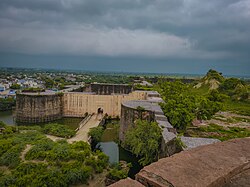Deeg | |
|---|---|
City | |
 Deeg Palace or Jal Mahal Deeg in Deeg, Rajasthan | |
 Deeg Fort in Deeg, Rajasthan | |
| Coordinates: 27°28′N 77°20′E / 27.47°N 77.33°E | |
| Country | |
| State | Rajasthan |
| District | Deeg |
| Founded by | Badan Singh |
| Government | |
| • Type | Municipal Council |
| • Body | Deeg Municipal Council |
| Elevation | 174 m (571 ft) |
| Population (2011) | |
| • City | 44,999 |
| • Urban | 44,999 |
| • Rural | 181,711 |
| Languages | |
| • Official | Hindi, Rajasthani, Braj Bhasa |
| Time zone | UTC+5:30 (IST) |
| Vehicle registration | RJ05 |
| Website | https://deeg.rajasthan.gov.in/home/dptHome |


Deeg is an ancient historical city in Deeg district of Rajasthan, India. It is carved out from its former district bharatpur on 7 August 2023. It is situated 32 kilometres (20 mi) north of Bharatpur and 98 kilometres (61 mi) northwest of Agra.
In Hindu mythology, Deeg was situated along the parikrama path of Krishna, which started at Goverdhan, 14 kilometres (8.7 mi) from Deeg. Some people[who?] identify it as the ancient town of "Dirgha" or "Dirghapur" mentioned in the epic Skanda Purana. Deeg was the first capital of the Sinsinwar Hindu Jat state of Bharatpur, when Maharaja Badan Singh was proclaimed its ruler in 1722. In 1730, Maharaja Suraj Mal built the strong fortress of Deeg. After Suraj Mal moved the capital to Bharatpur, Deeg became the second capital of the rulers of Bharatpur princely state. It is known for its number of forts, palaces, gardens and fountains.
